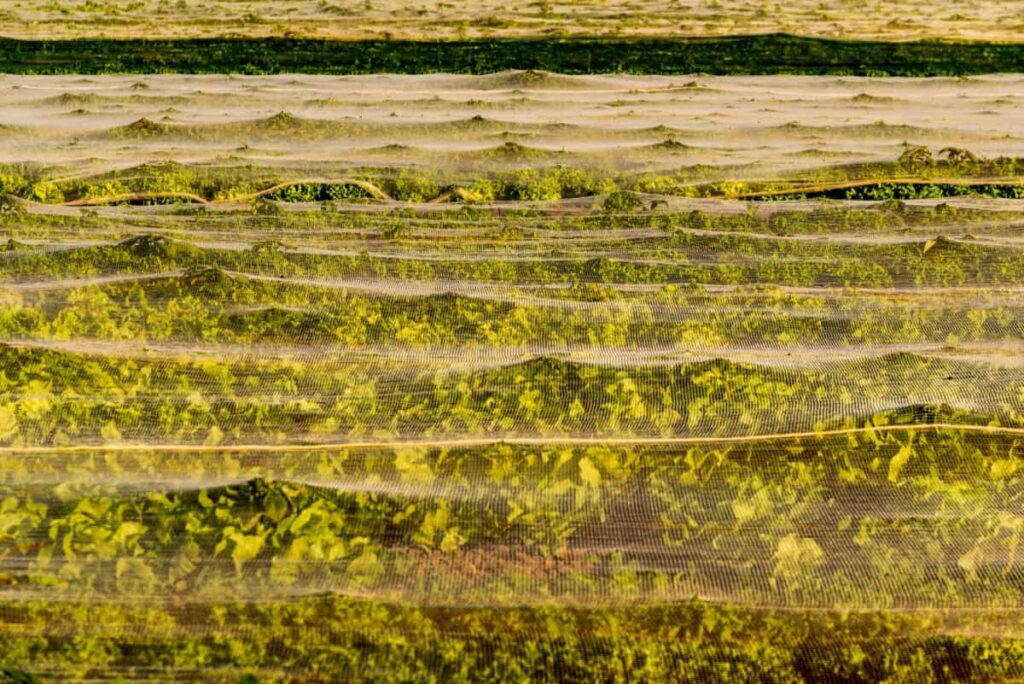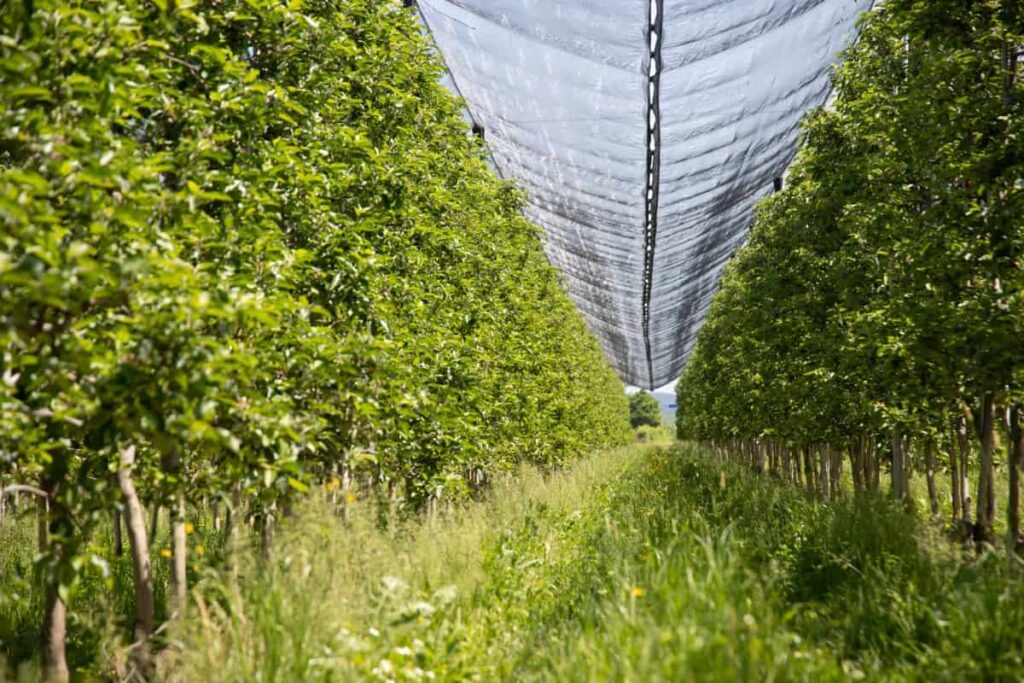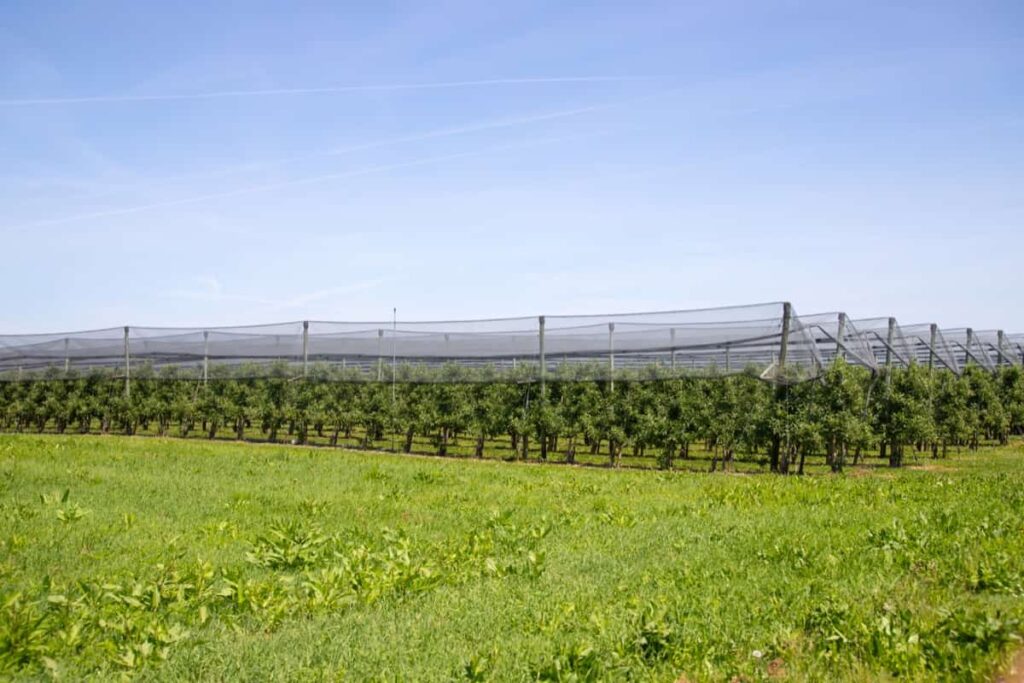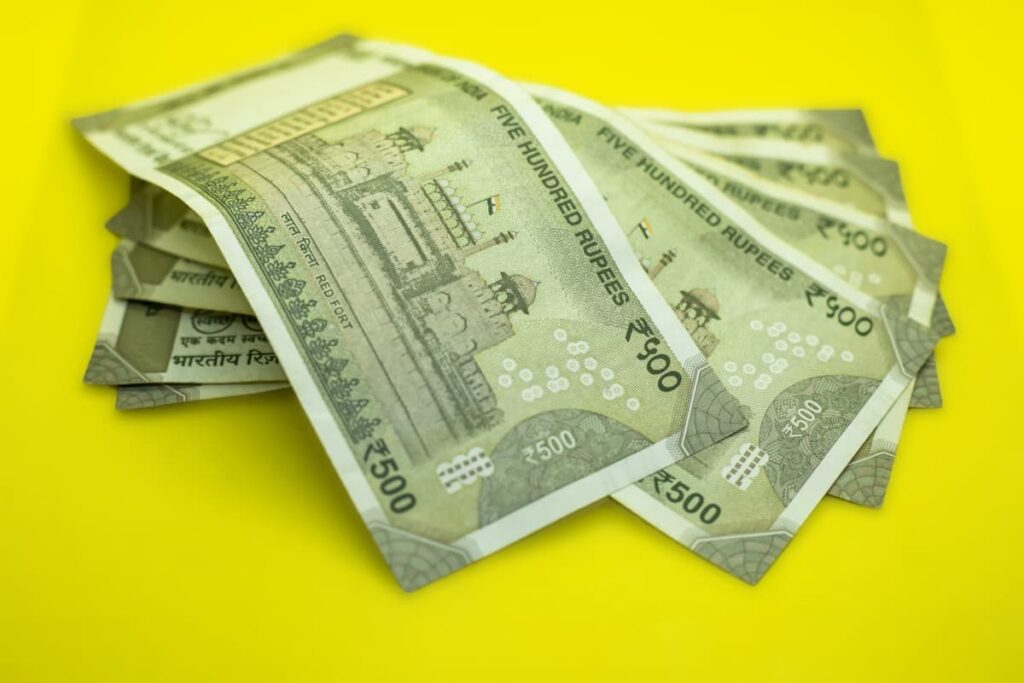The agriculture industry significantly contributes to India’s economy, accounting for nearly 18% of the country’s gross domestic product (GDP). However, the industry faces numerous challenges, including unpredictable weather conditions, pest infestations, and other environmental factors that can negatively impact crop yields. Agro shade nets offer a viable solution to these challenges, protecting from weather and pests while regulating temperature and humidity levels.

This comprehensive project report on agro shade net manufacturing in India provides an in-depth analysis of the types of shed nets, factors to consider, cost analysis, market demand, technical aspects of production, financial projections, legal requirements, marketing strategies, staffing and operations, SWOT analysis, and risks and mitigation strategies. The report aims to provide a complete roadmap for entrepreneurs interested in setting up agro shade net manufacturing units in India.
Project Report on Agro Shade Net Manufacturing in India
What are Agro Shade Nets?
Agro Shade Nets are specially designed nets made from high-quality polymer materials used in agriculture to protect crops from harsh weather conditions, insects, and pests. These nets are made by weaving long strips of plastic or other synthetic fibers together to create a mesh-like structure.
They come in different colors and shade levels, ranging from 30% to 90%, to suit different crop types and weather conditions. The material used in manufacturing agro shade nets is lightweight, durable, and resistant to UV rays, which makes them ideal for outdoor use. Additionally, these nets are easy to install, and their porous nature allows for proper air circulation, temperature control, and moisture retention, promoting healthy crop growth.
In case you missed it: A Comprehensive Guide to Crafting a Successful Shade Net Farming Business Plan

Importance of Agro Shade Nets in Agriculture
- Protects crops from harsh weather conditions like excessive sunlight, heavy rain, hailstorms, and frost.
- Controls the temperature and humidity levels inside the shade net, creating an optimal environment for plant growth.
- Reduces the impact of insect infestations and pest attacks, improving crop yields and quality.
- Shields crops from UV rays, which can damage the leaves and reduce photosynthesis.
- Increases water-use efficiency by reducing evaporation and runoff, resulting in less water wastage and lower irrigation costs.
- Facilitates better pest management by reducing the need for chemical pesticides, leading to healthier and safer food products.
- Extends the growing season by protecting crops from extreme weather conditions, allowing for year-round cultivation.
- Increases the market value of the product by improving its quality, appearance, and shelf life.
- Provides a cost-effective and eco-friendly alternative to conventional farming methods, promoting sustainable agriculture practices.
Types of Agro Shade Nets
- Monofilament shade nets: Made from a single strand of polymer, these shade nets are durable and have high tensile strength. They provide up to 50% shade, ideal for hot and sunny climates.
- Multi–Filament shade nets: These shade nets are made from multiple polymer strands, making them thicker and more tearing-resistant. They provide up to 70% shade, making them ideal for use in areas with intense sunlight.
- HDPE shade nets: Made from high-density polyethylene, these shade nets are UV-stable and resistant to extreme weather conditions. They are water-resistant and durable, making them suitable for use in regions with frequent rains.
- Knitted shade nets: These shade nets are made from a single piece of polymer and provide uniform and continuous shade coverage. They are ideal for greenhouse applications, allowing for easy ventilation and airflow.
- Agro shade net for Greenhouses: Specifically designed for use in greenhouses, these shade nets provide optimal shade and protection for plants. They help regulate temperature and humidity levels, ensuring healthy crop growth.
- Laminated shade nets: Made from multiple polymer layers, these shade nets are durable and tear-resistant. They provide stable shade coverage and are suitable for use in areas with heavy winds.
Applications of Agro Shade Nets
- Nursery: Agro shade nets protect young plants from direct sunlight and extreme weather conditions, ensuring their healthy growth.
- Greenhouses: Shade nets provide ideal light and temperature conditions for growing crops in greenhouses, resulting in better crop yields and quality.
- Fruits and vegetables: Agro shade nets protect fruits and vegetables from sunburn, insects, and birds, ensuring better crop yields.
- Floriculture: Agro shade nets are used in floriculture to regulate light and temperature conditions, leading to better plant growth and flower production.
- Livestock farming: Shade nets are used in livestock farming to provide shade and reduce heat stress, ensuring better animal health and productivity.
- Poultry farming: Agro shade nets are used in poultry farming to provide shade and prevent direct sunlight, ensuring better egg production.
- Aquaculture: Shade nets regulate light and temperature conditions, leading to better fish growth and productivity.
- Seed production: Agro shade nets protect seedlings from extreme weather conditions, producing better quality.
- Research and dDevelopment: Shade nets are used in research and development activities to create controlled plant growth and testing environments.
- Urban agriculture: Shade nets are used in urban agriculture to create microclimates and optimize crop yields in small spaces such as rooftops and balconies.
In case you missed it: Indian Government Subsidies for Polyhouse Farming: How to Double Your Agricultural Profits

Factors to Consider When Choosing Agro Shade Nets
- Shade percentage: The shade percentage required depends on the crop type, location, and climate.
- Durability: The shade net’s durability and resistance to tear, puncture, and UV rays determine its lifespan.
- Material: The shade net’s material determines its strength, UV stability, and resistance to extreme weather conditions.
- Color: The color of the shade net affects the light transmission and heat absorption, depending on the crop’s needs.
- Size: The net shade size should match the application’s area to ensure optimal coverage.
- Cost: The cost of the shade net should be reasonable and fit within the budget.
- Supplier: The supplier’s reputation, experience, and quality of products should be considered to ensure customer satisfaction.
Installation and Maintenance of Agro Shade Nets
To ensure the effectiveness and longevity of agro shade nets, they should be installed tightly, cleaned regularly with water and mild soap, and any damages repaired immediately. They should be stored in a protected place when not in use. Shade nets should be replaced when worn out or damaged beyond repair. Adequate training should be provided to workers on the installation, maintenance, and repair of shade nets.
Manufacturing Process of Agro Shade Nets
- Selection of raw materials: High-density polyethylene (HDPE) is the most commonly used material for making agro shade nets due to its strength and durability.
- Extrusion: The raw material is melted and extruded through a die to form a continuous plastic sheet.
- Knitting: The extruded plastic sheet is knitted using machines to form a net-like structure. This process can be done with single or multiple strands of polymer.
- Coloring: The shade net can be dyed using different colors to improve visibility or to meet specific market demands.
- Finishing: The shade net is finished by applying UV stabilizers to protect against degradation caused by prolonged exposure to sunlight.
- Cutting: The finished shade net is cut to the required length and width per the customer’s demand.
- Packaging: The final product is packaged and stored in a dry and cool environment.
Machinery and Equipment for Agro Shade Nets Manufacturing
- Extruder machine: Used for melting and extruding the polymer into long strands.
- Knitting machine: Used to knit the polymer strands into a net-like structure.
- Warping machine: Used to prepare the warp beam for the knitting machine.
- Cutting machine: Used to cut the finished shade net into desired sizes.
- Lamination machine: Used for laminating the shade nets with multiple polymer layers for enhanced durability.
- Printing machine: Used for printing designs and logos on the shade nets.
The cost of equipment varies depending on the scale of the manufacturing project. Small-scale projects can be started with an investment of around INR 10 lakhs, while larger projects may require an investment of INR 50 lakhs or more. It is important to invest in high-quality machinery to ensure the production of durable and high-quality shade nets. Training on the operation and maintenance of the machinery should be provided to the workers to ensure safe and effective usage.
Cost-Benefit Analysis of Agro Shade Nets
A cost-benefit analysis is an important tool for businesses to determine the feasibility of manufacturing agro shade nets. The analysis considers the costs involved in the production and the benefits expected from the product sales of the medium size Agro shade nets manufacturing business.
In case you missed it: Sustainable Agriculture Practices: Eco-Friendly, Healthy Farming Benefits and Ideas

Costs
| Component | Cost (in INR) |
| Raw materials | 10,00,000 |
| Machinery and equipment | 8,00,000 |
| Labor | 3,00,000 |
| Utilities (electricity, water, etc.) | 1,50,000 |
| Rent/Lease | 1,20,000 |
| Transportation | 50,000 |
| Total Cost | 24,20,000 |
Benefits
| Component | Revenue (in INR) |
| Sales of Agro Shade Nets (expected sales of 10,000 nets) | 50,00,000 |
| Total Benefit | 50,00,000 |
Based on the above table, the total cost of producing agro-shade nets for a medium-scale business would be INR 24,20,000, while the expected revenue from selling 10,000 agro-shade nets is INR 50,00,000. This indicates a profit of INR 25,80,000, which demonstrates the potential for significant profitability in medium Scale agro shade net manufacturing.
Agro Shade Nets Growing Manufacturing Industry in India
Agro shade nets are synthetic fabric nets used to decrease the intensity of sunlight for crops or other purposes when required. The global shade net market is mainly driven by agriculture concerns, with shade nets protecting plants and crops from birds, insects, wind, and too much sunlight. Shade nets are long-lasting, strong, easy to install, and have high tensile strength.
They are also used in non-agricultural sectors, including waterparks, restaurant resorts, vehicle parking providers, and playgrounds. The market for shade nets is expected to grow as agricultural operations become more technologically advanced and the need for agricultural goods increases. The global shade net market is estimated to use more than 20% of the fibers used in the textile industry.
Shade nets are available in various forms and sizes, including agro shade nets, hail safety nets, thermal nets, bug-proofing nets, bird protection nets, and UV-stabilized agro ropes. Using agro-based materials is increasing to protect agro-products from the environment, birds, insects, and weeds. The construction and restoration sector also contributes to the global demand for green shade nets for safety reasons.
Comprehensive Project Report on Agro Shade Net
A comprehensive project report on Agro Shade Net is a detailed plan for starting and operating a business that produces shade nets for agricultural purposes. It includes research on the market, technical aspects of manufacturing, financial projections, legal requirements, marketing strategies, staffing, and operations. The report also covers a SWOT analysis and risk mitigation strategies. This report provides a roadmap for entrepreneurs to establish and manage an Agro Shade Net manufacturing business successfully.
Market Research for Agro Shade Net Manufacturing
Before starting a business, market research is essential to understand the market demand, competitors, target audience, and pricing strategy. India’s agro shade net market is growing due to increased crop protection and yield enhancement demand. The global shade net market is expected to grow at a CAGR of 4.5% from 2021 to 2028.
In case you missed it: List of Agricultural Schemes in India: Every Farmer Must Know These

The demand for shade nets is increasing in horticulture, floriculture, and nursery due to the growing demand for export-quality produce. The major manufacturers in the Indian market are Green Agro Shade Nets, Shaktiman Agro Industries, Alok Enterprise, and Indonet Plastic Industries.
Technical Aspects in Agro Shade Net Manufacturing
The manufacturing process of agro shade nets includes extrusion, knitting, and stretching. The raw materials used in the production are high-density polyethylene (HDPE) and ultraviolet (UV) stabilizers. The machines required for manufacturing are extruder machines, looms, warping machines, winding machines, and stretching machines. The cost of the machinery ranges from INR 10 lakhs to INR 1 crore, depending on the scale of production.
Financial Projections for Agro Shade Net Manufacturing
The financial projections of the agro shade net manufacturing business depend on the scale of production, market demand, pricing strategy, and operational costs. The total investment required for a medium-scale manufacturing unit is around INR 50 lakhs. The revenue generated in the first year of operation is estimated to be INR 1 crore, with a net profit of INR 10 lakhs. The payback period for the investment is around five years.
Legal Requirements for Agro Shade Net Manufacturing
- Registration of the business under the Companies Act or Partnership Act
- Obtaining a Trade License from the local Municipality or Panchayat
- Obtaining a GST Registration
- Obtaining a Pollution Control Board (PCB) Clearance
- Obtaining a Fire License
- Obtaining a Factory License from the Department of Industries
Marketing Strategy for Agro Shade Net Manufacturing
The marketing strategy for the agro shade net manufacturing business includes targeting potential customers such as farmers, horticulturists, floriculturists, and nursery owners. The marketing channels include online platforms, social media, exhibitions, and local distributors.
In case you missed it: How to Start Bio Farming/Agriculture: A Step-By-Step Guide for Beginners

Staffing and Operations for Agro Shade Net Manufacturing
The staffing requirement for the agro shade net manufacturing business includes production supervisors, machine operators, technicians, and marketing executives. The production process involves the following operations:
- Raw material procurement and storage
- Extrusion, knitting, and stretching
- Quality control and inspection
- Packaging and dispatch
SWOT Analysis of Agro Shade Net Manufacturing
Strengths
- Growing market demand
- High-profit margins
- Diversification of products
Weaknesses
- Dependence on raw material suppliers
- Competition from established players
Opportunities
- Export potential
- Expansion to other regions
Threats
- Fluctuations in raw material prices
- Economic slowdown
Risks and Mitigation Strategies for Agro Shade Net Manufacturing
The risks involved in the agro shade net manufacturing business are fluctuating raw material prices, labor unrest, and market competition. The mitigation strategies include maintaining a stable supply chain, maintaining good labor relations, and developing innovative products.
Conclusion
Agro shade net manufacturing business presents a promising opportunity in India with growing demand in both the agricultural and non-agricultural sectors. Proper planning, execution, and management can lead to a successful and profitable venture.
- Profitable Village Farming Business Ideas in 2024
- High-Yield Aquaculture: Fast-Growing Fish for Farming
- Effective Fish Pond Construction Techniques for Beginners
- Irrigation and Water Management in Pineapple Farming
- Blossom to Harvest: Mastering Flowering and Pollination in Papaya Farming
- Pig Fattening Essentials: From Selection to Sale for Beginners
- Raising Wagyu Cattle: A Complete Guide for Premium Beef Production
- Soil Types and Their Water Holding Capacity
- Optimizing Irrigation Schedules for Coconut Groves for Enhanced Yield
- Espresso Your Garden: Coffee Grounds for Healthier Acid-Loving Plants
- The Best Soil Mix for Snake Plants: How to Mix Your Own Snake Plant Soil
- Green Thumb Success: Expert Tips for Cultivating Greenhouse Beans All Year Round
- Bloom All Year Round: The Ultimate Guide to Indoor Hyacinth Care
- Eco-Friendly Gardening: How to Make Liquid Fertilizer from Kitchen Waste
- Ultimate Guide to Grow Anise in Pots: Explore Seed Propagation to Harvesting
- Guide to Raising Chester White Pigs: Discover Breed Facts to Growth Management
- Mastering the Elegance: The Ultimate Guide to Weeping Cherry Tree Care, Planting, and Maintenance
- Ultimate Guide to Planting Garlic in Grow Bags: Growing Strategies for Beginners
- How to Fix Spider Plant Leaf-Related Problems: Natural and Organic Remedies
- 10 Reasons Why Your Tulsi Plant is Shedding Leaves: Home Remedies and Solutions
- Optimizing Growth and Yield: The Advantages of Palm Bunch Ash Fertilizer
- Utilizing Neem Oil Extract as a Natural Pesticide for Hydrangea
- From Soil to Harvest: Various Ways in Which Farmers Can Use AI Tools
- Steps to Encourage and Induce Citrus Flowers: A Comprehensive Guide
- How to Fix Snake Plant Leaf-Related Issues: Natural and Organic Remedies
- Transform Your Garden into a Fragrant Oasis with Raat Ki Rani (Night Blooming Jasmine)
- Discover the Ideal Chicken Breeds for Philippine Farms
- How to Create a Poultry Egg Farm Business Plan for Profits
- Grow Lemon Cucumbers Like a Pro: Insider Techniques for Bountiful Yields
- Ultimate Guide to Caring for Your Pink Princess Philodendron: Tips for Thriving Variegation
- Areca Nut Profit Per Acre: Calculating Yield and Cost of Cultivation
- How Kaveri Chicken is Becoming a More Profitable Breed in Indian Backyards
- Transform Your Barn: 9 Steps to Convert a Horse Stall into a Chicken Coop
- Exploring Suffolk Sheep Disadvantages with Limitations and Challenges
- Guide to Solving Potted Lemon Tree Problems: How to Revive Lemon Tree in Containers
- Steps to Encourage Female Pumpkin Flowers: Best Strategies for More Flowers and High Yields

Let me know how to obtain the Agricultural shade net manufacturing full report.
Also let me know what kind of support Asiafarming can extend in export of this product to Europe.